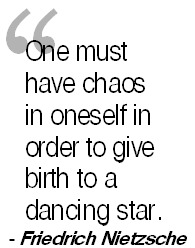Each week I intend to dispatch my pent-up creativity by creating a new version of something I call a “quotius”. (Learn about the genesis of it here.)
This is not your normal run-of-mill Quotius posting like I usually do.
Okay, it is a quote, well, sort of in a way at least it is. I mean, I’m quoting a collective group of people here but no one person in particular so there will be no attribution attached.
This is not only ground-breakingly different for me but I saved printer ink too because I just did it by hand with a marker.
The group I’m referring to, if you can believe it, is the population of biology researchers laboring away at labs all over the country.
I’m using a short list. I’ve stripped out everything extraneous so that all I’m left on it is six basic items. The professionals I’m quoting probably wouldn’t have done that themselves. They like long reports and white papers. They need those to justify their research funding.
The list includes the six main elements that make up the bulk of all living matter on planet earth: Carbon, Hydrogen, Nitrogen, Oxygen, Sulfur and Phosphorus.
In the video I’m keeping with my usual theme of showing my inherent lack of respect for a circular-shaped thinking pattern. As usual I make sure it meets with a quick if not painless end.
In the circular thinking model I show what the problem is. You can only read half of the items on the list. The other three appear upside down on the inside of the band. They are separated and alone.
With only three items instead of the required six you can’t end up with a living organism. If you work in a lab and these three are all you have you may have something organic but it’s most likely not living or breathing nor will if fetch a stick.
Nevertheless science has a name for it… It’s known as “dead”.
The same can be said of the pattern of circular thinking itself. All that one can do when you’re caught up within it is stay trapped in an endless spiral going further down the road of frustration and time loss.
So who am I to make such critical observations?
After all the closest I ever got to being a scientist was watching Star Trek on television after school more than forty years ago. But for the last two decades I’ve closely watched the way circular thinking has taken hold in so many people’s lives. Promoted by the rush and demands of life these days it has stolen more of its portion of our joy and happiness. If they would just slow down enough they would appreciate the fact that they can see their own potential and build a deep self-belief on that hard-evidence-based vision. All it takes is a simple little brain tweak and the direction we all desperately need can begin to come into focus.
My point, if I may say so myself, is visually well made. Thinking like this is as dead as the organic waste that only three basic elements can make. It’s thinking that needs to be changed.
In this video I reconstruct this old model by it taking apart and by giving one end a little tweak by twisting one end of it 180 degrees (like the coil in a DNA) before joining it with the other end.
We now see something new.
It’s a model of a mobius strip of course but, at the same time, it’s also a 3D illustration of a reciprocal system of thinking. Now in this form we can easily read all six elements one–by-one because this new strip only has one side and one edge. With this complete list of six items we have just about everything that’s needed to define every living organism in the physical world.
We also have a very elegant metaphor for the shape that this new thinking pattern takes on. I have been helping people for a long time to make this type of change and it doesn’t take long to do. One day at the most. The rewards are a greater self-confidence, less stress, and a much clearer pathway to get out from under the weight of the world.
And it’s all because of a well placed little twist and a little tweak.
More power to you.

PS: Have you noticed that a lot of personal development methods no longer pack the punch they once did? Could be the times. I went ahead and invented this simple little brain tweak that makes a huge difference in leveraging your efforts for creating a better version of yourself. Want more? Check out my FREE webinar here.
 The Annual New England Xylophone Symposium by DoKashiteru is licensed under a Attribution Noncommercial (3.0)
The Annual New England Xylophone Symposium by DoKashiteru is licensed under a Attribution Noncommercial (3.0)



